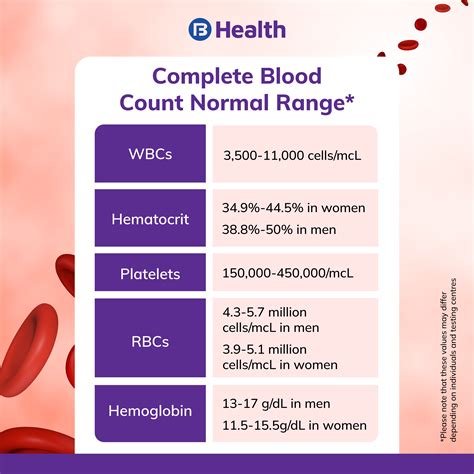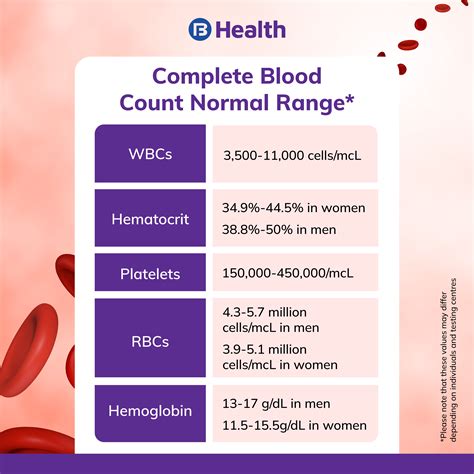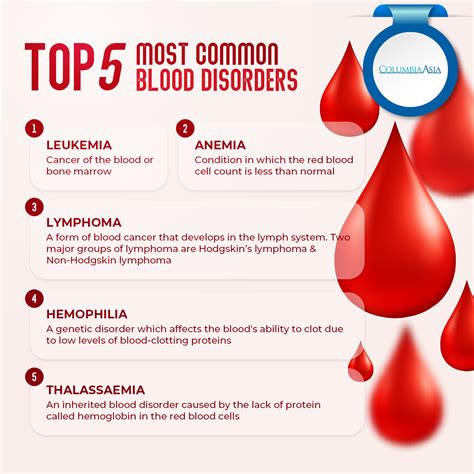Intro
Learn normal blood count values, including red blood cell, white blood cell, and platelet counts, to understand healthy hematology ranges and detect abnormalities, such as anemia or infection, with our guide to blood test results and reference ranges.
Normal blood count values are a crucial aspect of our overall health, and understanding what they mean can help us take better care of ourselves. A complete blood count (CBC) is a common blood test that measures various components of our blood, including red blood cells, white blood cells, platelets, and hemoglobin. These components play vital roles in our body's ability to transport oxygen, fight infections, and clot blood. In this article, we will delve into the importance of normal blood count values, what they indicate, and how they can impact our health.
The importance of normal blood count values cannot be overstated. Abnormal blood count values can indicate underlying health issues, such as anemia, infections, or blood disorders. For instance, a low red blood cell count can lead to fatigue, weakness, and shortness of breath, while a high white blood cell count can indicate the presence of an infection or inflammation. Furthermore, abnormal platelet counts can increase the risk of bleeding or clotting disorders. Therefore, it is essential to understand what normal blood count values are and how they can impact our health.
Normal blood count values are typically determined by a healthcare professional, who will interpret the results of a CBC test. The test measures various parameters, including hemoglobin, hematocrit, red blood cell count, white blood cell count, platelet count, and mean corpuscular volume (MCV). Each of these parameters has a specific normal range, which can vary depending on factors such as age, sex, and medical history. For example, the normal range for hemoglobin is typically between 13.5 and 17.5 grams per deciliter (g/dL) for adult men and between 12 and 16 g/dL for adult women.
Understanding Normal Blood Count Values

Understanding normal blood count values requires knowledge of the various components of blood and their functions. Red blood cells, also known as erythrocytes, carry oxygen from the lungs to the body's tissues. White blood cells, or leukocytes, play a crucial role in the immune system, helping to fight infections and diseases. Platelets, or thrombocytes, are responsible for blood clotting, which helps to prevent excessive bleeding. Hemoglobin, a protein in red blood cells, carries oxygen from the lungs to the body's tissues.
Red Blood Cell Count
The red blood cell count is an essential parameter in a CBC test. A normal red blood cell count ranges from 4.32 to 5.72 million cells per microliter (µL) for adult men and from 3.90 to 5.03 million cells per µL for adult women. A low red blood cell count can indicate anemia, while a high count can suggest dehydration or polycythemia.White Blood Cell Count
The white blood cell count is another critical parameter in a CBC test. A normal white blood cell count ranges from 3,500 to 10,500 cells per µL. A low white blood cell count can increase the risk of infections, while a high count can indicate the presence of an infection or inflammation.Importance of Normal Blood Count Values

Normal blood count values are essential for maintaining good health. Abnormal blood count values can indicate underlying health issues, such as anemia, infections, or blood disorders. For instance, a low red blood cell count can lead to fatigue, weakness, and shortness of breath, while a high white blood cell count can indicate the presence of an infection or inflammation. Furthermore, abnormal platelet counts can increase the risk of bleeding or clotting disorders.
Benefits of Normal Blood Count Values
Maintaining normal blood count values has several benefits, including: * Reduced risk of anemia and related complications * Improved immune function * Reduced risk of infections and diseases * Improved blood clotting and reduced risk of bleeding disorders * Improved overall health and well-beingFactors that Affect Normal Blood Count Values

Several factors can affect normal blood count values, including:
- Age: Blood count values can change with age, with older adults tend to have lower red blood cell counts and higher white blood cell counts.
- Sex: Men tend to have higher red blood cell counts and hemoglobin levels than women.
- Medical history: Certain medical conditions, such as anemia, can affect blood count values.
- Medications: Certain medications, such as blood thinners, can affect blood count values.
- Lifestyle factors: Lifestyle factors, such as smoking and exercise, can also affect blood count values.
How to Maintain Normal Blood Count Values
Maintaining normal blood count values requires a healthy lifestyle and regular medical check-ups. Here are some tips to help maintain normal blood count values: * Eat a balanced diet rich in iron, vitamin B12, and folate * Exercise regularly * Avoid smoking and excessive alcohol consumption * Get enough sleep and manage stress * Regular medical check-ups to monitor blood count valuesCommon Blood Disorders

There are several common blood disorders that can affect blood count values, including:
- Anemia: A condition characterized by low red blood cell count or hemoglobin levels.
- Leukemia: A type of cancer that affects the blood and bone marrow.
- Lymphoma: A type of cancer that affects the immune system.
- Thalassemia: A genetic disorder that affects the production of hemoglobin.
- Sickle cell disease: A genetic disorder that affects the production of hemoglobin.
Symptoms of Blood Disorders
The symptoms of blood disorders can vary depending on the specific condition. Common symptoms include: * Fatigue and weakness * Shortness of breath * Pale skin * Headaches and dizziness * Frequent infections * Easy bruising and bleedingDiagnosis and Treatment of Blood Disorders

Diagnosis and treatment of blood disorders typically involve a combination of medical tests and treatments. Here are some common diagnostic tests and treatments:
- CBC test: A blood test that measures various components of blood, including red blood cells, white blood cells, and platelets.
- Bone marrow biopsy: A test that involves removing a sample of bone marrow tissue for examination.
- Imaging tests: Such as X-rays, CT scans, and MRI scans.
- Medications: Such as blood thinners, antibiotics, and chemotherapy.
- Blood transfusions: A procedure that involves transfusing healthy blood cells into the body.
Prevention of Blood Disorders
Prevention of blood disorders requires a healthy lifestyle and regular medical check-ups. Here are some tips to help prevent blood disorders: * Eat a balanced diet rich in iron, vitamin B12, and folate * Exercise regularly * Avoid smoking and excessive alcohol consumption * Get enough sleep and manage stress * Regular medical check-ups to monitor blood count valuesWhat is a normal blood count value?
+A normal blood count value is a range of values that indicate good health. The normal range for hemoglobin is typically between 13.5 and 17.5 grams per deciliter (g/dL) for adult men and between 12 and 16 g/dL for adult women.
What factors can affect normal blood count values?
+Several factors can affect normal blood count values, including age, sex, medical history, medications, and lifestyle factors such as smoking and exercise.
How can I maintain normal blood count values?
+Maintaining normal blood count values requires a healthy lifestyle and regular medical check-ups. Eat a balanced diet rich in iron, vitamin B12, and folate, exercise regularly, avoid smoking and excessive alcohol consumption, get enough sleep and manage stress, and have regular medical check-ups to monitor blood count values.
In conclusion, normal blood count values are essential for maintaining good health. Understanding what normal blood count values are and how they can impact our health can help us take better care of ourselves. By maintaining a healthy lifestyle and regular medical check-ups, we can reduce the risk of blood disorders and maintain normal blood count values. If you have any questions or concerns about your blood count values, be sure to consult with your healthcare professional. Share this article with your friends and family to help them understand the importance of normal blood count values.
